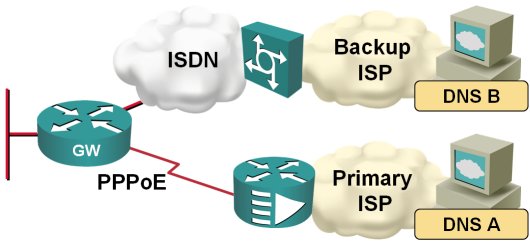Category: DNS
Setup DNS server in your lab
Configure DNS Servers Through IPCP
After I've fixed the default routing in my home office, I've stumbled across another problem: the two ISPs I'm using for my primary and backup link have DNS servers that reply solely to the DNS requests sent from their own IP address range:

When the traffic is switched from the primary to the backup ISP, I therefore also need to switch the DNS servers. Fortunately, this is quite easy to do on a router; you just need to configure ppp ipcp dns request on the dialer interface and the router starts asking for the DNS server address as part of the IPCP negotiation.
The DNS configuration "challenges"
Let's start with the DNS resolvers (the DNS name servers the router itself uses when it needs to change a name into an IP address or vice versa):
- You can configure the DNS resolvers with the ip name-server global configuration command or the domain name-server configuration command within the ip dns view default.
- Both lists are merged and combined with the IP addresses acquired from the DHCP reply messages to get the final list of the DNS resolvers. You can inspect the final list with the show ip dns view default command.
- The DNS name servers from the DHCP replies never appear in the router configuration.
- If the same IP address is specified with the ip name-server and domain name-server command, only the global (ip name-server) command will appear in the router configuration.
The rules for DNS forwarders (the DNS servers the router uses to answer incoming DNS queries) are a bit different:
- The DNS view the current DNS query should use is determined based on view-list assigned to incoming interface (with the ip dns view-group interface configuration command) or the global view-list (specified with the ip dns server view-group global configuration command).
- The incoming query is (sequentially) sent to the IP addresses configured as dns forwarders in the selected view. No other DNS servers are used.
- If the selected view has no dns forwarders, but contains domain name-servers, they are used as forwarders.
- If the selected view has no dns forwarders or domain name-servers, the query is forwarded as IP broadcast ... unless the selected view is the default view, in which case the first DNS server computed according to the the previous bullet list is used (only one DNS server is used in this case, even if you have configured multiple DNS servers with the ip name-server configuration command).
Unbundle DNS settings from DHCP client
To stop the router's DHCP client from overwriting the static name-server settings, use the no ip dhcp client request dns-nameserver interface configuration command (you can also exclude a few other DHCP options).
DNS resolver in Cisco IOS is auto-configured with parameters from a DHCP reply
To avoid total confusion, you thus have these options:
- Do not use DHCP to acquire IP interface addresses
- Make sure the DHCP server does not send DNS-related parameters (a bit hard if you're using DHCP with your ISP)
- Rely exclusively on DHCP to provide your router with the DNS name server addresses
Protecting the primary DNS server on your router
Apart from having too many valid DNS requests for the zone the router is responsible for, the observed behavior could be spam-related. Just a few days ago when I've discussed the router-based DNS server with my security engineers, they've pointed out that a lot of spammers perform regular DNS attacks trying to poison the DNS cache of unpatched open caching DNS servers.
Obviously, a router is no match in raw CPU power to a high-end server, so even when running the authoritative server on the router, it might not be a bad idea to use a DNS server of your ISP as the secondary DNS and list only the ISP's DNS server in the NS records for your zone. This would deflect most of the traffic (as nobody would know your router is acting as a DNS server), but I would still apply an inbound access-list allowing only DNS queries from the secondary name server on the Internet-facing interface.
Alternatively, you could protect the router with Control Plane Policing and drop excessive DNS request packets, but that would affect the queries you should respond to as well.
DNS views are broken in release 12.4(11)T
Use your Cisco router as a primary DNS server
DNS server for a zone, use the ip dns primary command, for example:
Next, you need to define primary and secondary name servers for the domain.ip dns server
ip dns primary website.com soa ns.website.com
[email protected] 86400 3600 1209600 86400
Use the ip host ns command:
ip host website.com ns ns.website.comYou can also define mail routing for the domain with the ip host mx command:
ip host website.com ns ns.isp.com
ip host website.com mx 10 mail.website.com
ip host website.com mx 20 mail.isp.com
Finally, you need to define hosts within your domain (with the traditional form of the ip host command):
ip host ns.website.com 192.168.0.1 ! router's IP address
ip host www.website.com 192.168.1.1
ip host website.com 192.168.1.1 ! alternate for www.website.com
ip host mail.website.com 192.168.1.2
